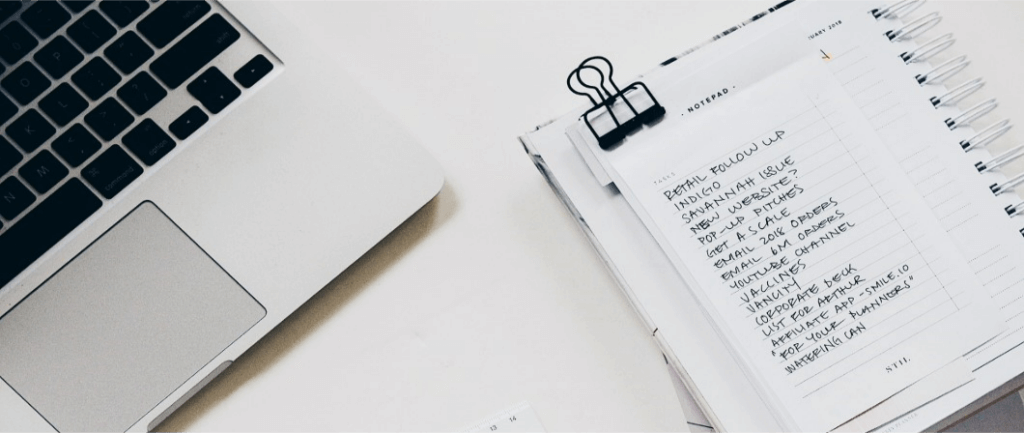You have a project to finish, and you’re determined to buckle down and get it done. But first, you decide to quickly check your email. A minute later, you have a eureka moment for that presentation tomorrow. Also, what wine will go well with your dinner tonight? And perhaps another quick check of your email.
These disruptive thoughts are internal distractions, and they can chip away at your ability to focus during the workday. And unlike with chatty coworkers, you can’t just slip on a pair of noise-canceling headphones or a “do not disturb” sign to get away from them.
The distractions list technique is a tool for managing these self-inflicted interruptions, enabling you to get back to the task at hand much more quickly. Let’s explore what causes internal distractions, the consequences for productivity, and how you can use a distractions list to increase your focus.
What are Internal Distractions?
There are two main types of distractions:
- External Distractions – This happens when an external stimulus from the outside world interrupts your train of thought, whether it’s a ringing phone, an email notification, or a colleague asking a question.
- Internal Distractions – Here, a thought, emotion, or urge hijacks your focus. The trigger is self-inflicted.
Of course, these distractions can overlap. An external distraction could easily become internal if you start dwelling on it. Likewise, an internal distraction (wanting to check your phone or even just look out of the window) could lead to all sorts of external distractions. For instance, a co-worker might think you’re free to talk.
Internal Distractions as Productivity Killers
You’re probably very aware of the impact external distractions can have, but internal ones can pose just as big a threat to your productivity.
They can prompt constant task switching, rather than giving each task the uninterrupted focus it needs. The University of California at Irvine found that, on average, workers switched tasks every 3 minutes. Around 49% of these interruptions were self-inflicted. The study also found that after being pulled away from a task, it can take twenty-three minutes to get back on track.
Even when you don’t act on your distracting thoughts, there are still negative consequences. Studies have shown that non-task-related thoughts such as mentally rehashing a previous conversation or mind-wandering (when not done mindfully) can split our attention and negatively impact our performance on cognitively demanding tasks.
What Causes Internal Distractions?
Why are our own brains seemingly so intent on sabotaging our focus? Let’s explore some possible reasons behind internal distractions.
Natural Focus Cycles
According to a commonly cited study from Harvard, our minds naturally wander roughly 47% of the time. This can be really beneficial if you have a free moment as mindful daydreaming can be conducive to creativity and problem-solving. But if you’re trying to focus on a particular task, mind-wandering can introduce a flood of distracting thoughts, impacting your focus. It might happen more often when you’re finding a task tedious. And further studies have suggested that the mind strays when it doesn’t feel sufficiently challenged.
There’s also some evidence to suggest that our brains are constantly cycling through different levels of focus without us being consciously aware of it. Academics from UC Berkeley and Princeton explained to Wired that this could be an evolutionary leftover from more dangerous times. They theorize that our brains regularly come out of deep focus to make sure there’s nothing more pressing we should be aware of (like an oncoming predator) before returning to the task.
So, even when you feel focused, you could be going through very short bursts of being highly distractable.
Feeling Like You Have Unfinished Tasks
Many distracting thoughts could simply be desperate attempts by our brains to hold onto important information.
This is closely linked to what’s known as the Zeigarnik Effect, where we remember unfinished tasks better than completed ones due to the nature of our short-term memory. Speaking to The Harvard Business Review, psychologist Roma Kumar describes it like this: “When a task isn’t complete, our brains constantly rehearse it to keep the information active.”
So, when you think of something you need (or want) to do while you’re focusing on something else, your brain will keep returning to that unresolved thought to make sure you don’t forget.
Reward Seeking
Another reason we fixate on internal distractions is that, as a species, humans are hardwired to seek out things that trigger a release of dopamine. That’s the “feel good” neurochemical that’s closely related to motivation and reward.
As lecturer and author Nir Eyal explains to The New York Times: “The reason we lose focus most of the time is because we are looking to escape some kind of discomfort, such as stress, anxiety, loneliness or boredom.” Every distraction (external or internal) has the potential to be more rewarding than the current task.
This can go some way to explaining our constant need to check our inboxes as social interaction is a key trigger for dopamine. The unpredictable nature of the trigger (we never know when a new message might pop up) also contributes. As staff at Harvard University’s Science in the News blog explain: “If we perceive a reward to be delivered at random, and if checking for the reward comes at little cost, we end up checking habitually.”
Additionally, there’s some scientific evidence to suggest a link between novelty and dopamine. If you’ve been focusing on the same task for a long time, your brain will start to crave something different (even if it’s just an alternate work task) to get that dopamine hit.

Using a Distractions List to Manage Internal Distractions
The distractions list technique is exactly what it sounds like – keeping a comprehensive list of all the internal distractions that come up while you’re working on a task.
You jot down a note about the thought as soon as it crosses your mind and then return to work without pursuing it any further. So, if your instinct is to check your email, you’d write, thought about checking email, and then return to your task.
This might seem counterintuitive. You might not be acting on the distracting thought, but you are breaking off what you’re doing to acknowledge it. However, the technique addresses several of the root causes of internal distractions.
First, it’s a way of documenting the interruptions so you can attend to any important ones later. As clinical psychologist Nick Wignall explains: “By keeping a distractions list, you’re effectively reassuring your mind that you have a reliable system for remembering these important things. And if you get in the habit of keeping a distractions list, eventually your mind will really start to trust that you will remember important things.” This means your brain will become more comfortable with unfinished tasks, reducing the urge to switch and cutting down on that tendency to constantly rehearse thoughts.
It isn’t a to-do list though. Rather than a premeditated plan, it’s a dynamic record of everything that crosses your mind during your task. So, you should still write down distracting thoughts even if there’s no chance you’ll need to attend to them later.
That’s because the act of writing thoughts down leads you to be much more conscious of them. The better you are at noticing and labeling your wandering thoughts, you’ll be less likely to get caught up in them without realizing it.
As productivity expert Chris Bailey explains in his book Hyperfocus: “The more you notice what’s occupying your attentional space, the faster you can get back on track when your mind begins to wander.”
Lastly, it’s a helpful source of data as it enables you to track your distractions over time. For instance, if you notice that “wanted to check phone” comes up regularly, you could try putting your phone out of sight during focused work.
Top Tips for Using a Distraction List Effectively
Here are some tips for using a distractions list productively.
- Separate your list from what you’re doing. Keeping your list separate (ideally writing it by hand) means you keep your distractions properly siloed from the task.
- Make time to review it. The list is only effective if you take time later to see if the distractions need attending to. Spend a few minutes between tasks reviewing your list and see what can or should be acted on.
- Action your distractions. After reviewing them, work out when and how you can address the distractions. Hopefully, making a habit of this will help you trust yourself to remember more and cut down on those well-intentioned but unhelpful nudges from your brain.
Rein in Your Brain
Using a distractions list helps you stay focused by putting you more in control of your stray thoughts. While it can’t help you avoid all distractions completely (your phone is still going to ring on occasion, unfortunately), it does help you cut down on self-imposed interruptions and the false sense of urgency created by unfinished tasks.
Actively manage your internal distractions to vastly increase the amount of focused work you’re able to get done in between external distractions.






